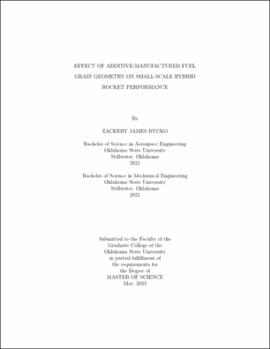| dc.description.abstract | This paper presents a parametric study of additive-manufactured fuel grain geometry on small-scale hybrid rocket performance. The motivation of this study is to understand and increase hybrid rocket performance to be a more viable option when compared to solid and liquid rocket propulsion systems. Hybrid rocket engine systems consist of two different propellant components: a solid fuel and a liquid or gaseous oxidizer. This research evaluates the use of additive-manufactured polylactic acid filament as a potential propellant in a hybrid rocket propulsion system. Additive-manufactured fuel grains provide an engine system capable of reduced operational expenses, reduced operational hazards by having separate fuel and oxidizer, and highly tailorable rocket performance with custom grain geometry and composition. On top of all that, these fuel grains provide a safer alternative to the volatile nature of solid rocket propellants, as well as simplifying manufacturing and easing storage requirements associated with fuel grains. The primary goal of this study is to observe the variances in hybrid rocket engine performance as a function of differing infill densities and infill geometries present within the fuel grain. Because the practice of additive-manufactured fuel is new, the parameters associated with manufacturing fuel grains are largely not well understood when related to rocket engine performance. By adjusting the infill percentage and infill shape print pattern of the fuel, different thrusts, burn times, and burn rates can be achieved due to the change in surface area, density, and its reaction with the oxidizer flow. Performance variances were evaluated on a 38-mm diameter hybrid rocket engine system over fuel grains with three different infill densities of 30%, 50%, and 70% with cubic infill geometry. Performance variances were then evaluated on the same engine system over fuel grains with three different infill geometries of cubic, triangular, and concentric with a 50% infill density. Small sample ANOVA testing at a 95% confidence interval concludes that there are significant statistical differences in the mean for average thrust, total impulse, specific impulse, and regression rate for the infill density testing campaign. However, small sample ANOVA tests were unable to deduce a significant statistical difference in the means for any of the infill geometry cases. Although no statistical significance was present, certain trends were still able to be deduced which warrants testing for larger scale HREs. Follow-up work includes increasing the scale of the HRE in diameter and case length, comparisons between PLA and ABS in terms of performance and consistency, variation of port geometry and its effects on thrust profiles and regression rate, and using certain additives such as metal powders to affect the burn rate and thrust produced. | |
